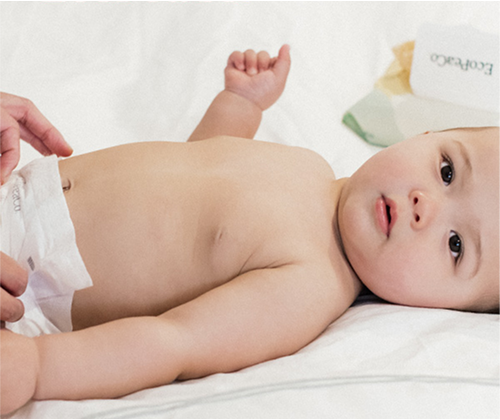A baby’s skin is often the softest, loveliest texture a parent has ever felt. But unfortunately, that silky skin can be prone to rashes and other uncomfortable conditions. These skin flare-ups can result from exposure to synthetic materials, chemicals, dyes, certain foods, and a number of other factors. This can be distressing for both baby and parent, but luckily there are various ways to support a baby with sensitive skin, and minimize skin-related ailments.
From diaper and wipe recommendations, to products that are kind to sensitive skin, here are some suggestions to help your baby’s skin stay calm and clear.
Use hypoallergenic diapers and wipes.
Did you know that many standard diapers contain chemicals, additives, fragrances, phthalates, latex, and BPA? That’s right. And these ingredients can easily irritate sensitive skin. Because of this, it’s best to purchase hypoallergenic diapers that are free of chemicals, additives, fragrances, phthalates, and other toxins. Same goes for wipes, which often have similar irritants.
When something is labeled “hypoallergenic,” it means it has a lower chance of causing an allergic reaction because it has few to no chemicals and additives.
Purchase larger diapers.
A major culprit of diaper rashes is too-tight diapers, especially for babies with sensitive skin. When a diaper is really snug it causes friction on baby’s skin, which can lead to chafing and a painful rash. The remedy is buying the next size up if you notice your baby’s diapers are fitting like a glove, and not fastening the diaper too tight during changes.
Change diapers more frequently.
The longer a baby sits in a dirty diaper, the longer bacteria and yeast have to impact baby’s skin. Minimize this risk by changing baby’s diaper as soon as you notice it’s soiled, and thoroughly cleaning urine and fecal matter out of all crevices, as leftover particles could lead to a rash.
Look for dermatologist-tested products.
Whenever you see a product with the “dermatologist-tested” label, it means that an expert in skin conditions analyzed the product and confirmed it’s unlikely to cause adverse effects. Looking for this term on labels can help you select products that are safe for your baby’s sensitive skin.
Invest in organic cotton clothing.
Rashes are often triggered by a build-up of moisture. And between sweat, drool, urine, and milk, babies are exposed to a lot of moisture, moisture that can become trapped on their skin if they’re wearing clothing that doesn’t “breathe.” You can reduce this issue by opting for clothing made of organic cotton. This type of material is incredibly breathable (allowing moisture to quickly evaporate,) usually free of toxins, and softer than conventional cotton.
Switch to fragrance- and dye-free laundry detergent.
While we often look at what we put on baby’s skin when thinking about skin irritants, we often forget about laundry detergent. If baby’s clothes are washed with a laundry detergent filled with chemicals, a harmful residue can remain after washing. Luckily, there are many chemical-free detergents that primarily use gentle ingredients like water, organic soap, coconut oil, aloe vera, and essential oils.
Keep a food journal.
It’s not just what we put on baby’s skin that causes uncomfortable reactions - food can often be equally responsible for upsetting sensitive skin. To ensure a certain food isn’t the cause of baby’s rashes, keep a journal of any new food you feed them. If they’re primarily breastfed, keep track of any changes in the mom’s diet. Then, if baby develops a rash, you can reference the food journal to see if a new food could have been the cause.
Utilize coconut Oil.
There’s no need to purchase many of the expense diaper rashes and other creams on the market when you can simply utilize the wonders of coconut oil. This affordable, multi-purpose oil has antifungal and antimicrobial properties that can slow the Candida that causes some diaper rashes. It also reduces inflammation and increases hydration, minimizing the occurrence of itchy, dry skin.
Tip: While an allergy to coconut oil is rare, it’s best to first test out a small amount on baby’s skin.
Check labels for harmful ingredients.
While coconut oil can be used for a number of skin needs, you’ll still need products like sunscreen and body wash. To avoid products that contain harmful ingredients, reference our post “21 Ingredients to Always Avoid in Baby Products” [insert link] to discover what you don’t want to see on a label.
Look for certain terms on labels.
After looking into what you don’t want to see on a product label, you can consider the terms you do want to see. Following are common terms that indicate a brand has ensured particular harmful ingredients are not in their product.
-Paraben-free
-Fragrance-free
-No phthalates or Phthalate-free
-Talc-free
-Chlorine-free
-Not fire resistant
-MADE SAFE certified
-SLS- and SLES-free
-Dye-free
- Keep an eye on your baby.
Any time you expose your baby to a new product or material, or feed them a new food (as mentioned above), it’s important to look out for any changes in their skin, or overall demeanor. If you do notice a change, you’ll be in better shape to eliminate the problem.
Every parent’s top priority is keeping their baby safe and comfortable. Because of this, it can be especially distressing if they regularly have painful skin issues. We’re hopeful these tips can help ensure your baby’s skin remains free of discomfort, so parent and child can focus on the more joyful aspects of life.


